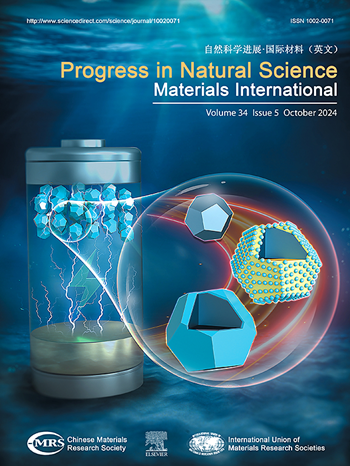XGBoost and CNN-based prediction of external forces and stress-strain during solidification reduction in casting
IF 7.1
2区 材料科学
Q2 MATERIALS SCIENCE, MULTIDISCIPLINARY
Progress in Natural Science: Materials International
Pub Date : 2025-08-01
DOI:10.1016/j.pnsc.2025.06.010
引用次数: 0
Abstract
The continuous casting reduction process can effectively improve defects such as central segregation and porosity in the billets, making it a key process for enhancing billets quality. This study aims to investigate the required external force during the solidification reduction process and the equivalent stress-strain distribution at various positions inside the billets, and to construct predictive models for equivalent stress-strain and external force based on the reduction amount. Through conducting laboratory ingot solidification process reduction tests and finite element numerical simulations, the corresponding parameters including external force, reduction amount, equivalent stress, and equivalent strain were obtained. Data augmentation and random noise processing were applied to the parameter features, and predictive models for external force using the XGBoost algorithm and for equivalent stress-strain using a convolutional neural networks were constructed. The results indicate that as the reduction amount increases, the required external force increases, and the equivalent stress-strain inside the billet is much higher than at the surface. Furthermore, in the external force prediction model, the MAPE value of the XGBoost algorithm is 8.15 %, while in the equivalent stress-strain model, the R2 value of the convolutional neural networks training set is 0.92. These results demonstrate that both the external force prediction model and the equivalent stress-strain prediction model exhibit high accuracy, and robustness in predictive tasks.
基于XGBoost和cnn的铸件凝固还原过程中外力和应力应变预测
连铸还原工艺能有效改善铸坯中心偏析、气孔等缺陷,是提高铸坯质量的关键工艺。本研究旨在研究凝固还原过程中所需的外力以及坯料内部各位置的等效应力-应变分布,并建立基于还原量的等效应力-应变和外力预测模型。通过室内钢锭凝固过程还原试验和有限元数值模拟,得到了相应的外力、还原量、等效应力、等效应变等参数。对参数特征进行数据增强和随机噪声处理,构建了基于XGBoost算法的外力预测模型和基于卷积神经网络的等效应力应变预测模型。结果表明:随着压下量的增加,所需外力增大,坯料内部的等效应力应变远高于表面;在外力预测模型中,XGBoost算法的MAPE值为8.15%,而在等效应力-应变模型中,卷积神经网络训练集的R2值为0.92。结果表明,所建立的外力预测模型和等效应力-应变预测模型均具有较高的预测精度和鲁棒性。
本文章由计算机程序翻译,如有差异,请以英文原文为准。
求助全文
约1分钟内获得全文
求助全文
来源期刊
CiteScore
8.60
自引率
2.10%
发文量
2812
审稿时长
49 days
期刊介绍:
Progress in Natural Science: Materials International provides scientists and engineers throughout the world with a central vehicle for the exchange and dissemination of basic theoretical studies and applied research of advanced materials. The emphasis is placed on original research, both analytical and experimental, which is of permanent interest to engineers and scientists, covering all aspects of new materials and technologies, such as, energy and environmental materials; advanced structural materials; advanced transportation materials, functional and electronic materials; nano-scale and amorphous materials; health and biological materials; materials modeling and simulation; materials characterization; and so on. The latest research achievements and innovative papers in basic theoretical studies and applied research of material science will be carefully selected and promptly reported. Thus, the aim of this Journal is to serve the global materials science and technology community with the latest research findings.
As a service to readers, an international bibliography of recent publications in advanced materials is published bimonthly.

 求助内容:
求助内容: 应助结果提醒方式:
应助结果提醒方式:


